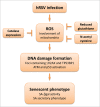Increasing the complexity of respiratory syncytial virus infection: Reactive oxygen species, DNA damage, and premature senescence
- PMID: 27008410
- PMCID: PMC4871652
- DOI: 10.1080/21505594.2016.1162370
Increasing the complexity of respiratory syncytial virus infection: Reactive oxygen species, DNA damage, and premature senescence
Figures


Comment on
-
Induction of DNA double-strand breaks and cellular senescence by human respiratory syncytial virus.Virulence. 2016 May 18;7(4):427-42. doi: 10.1080/21505594.2016.1144001. Epub 2016 Jan 25. Virulence. 2016. PMID: 26809688 Free PMC article.
Similar articles
-
Induction of DNA double-strand breaks and cellular senescence by human respiratory syncytial virus.Virulence. 2016 May 18;7(4):427-42. doi: 10.1080/21505594.2016.1144001. Epub 2016 Jan 25. Virulence. 2016. PMID: 26809688 Free PMC article.
-
Proline dehydrogenase promotes senescence through the generation of reactive oxygen species.J Cell Sci. 2017 Apr 15;130(8):1413-1420. doi: 10.1242/jcs.196469. Epub 2017 Mar 6. J Cell Sci. 2017. PMID: 28264926
-
Oxygen-Sensing Nox4 Generates Genotoxic ROS to Induce Premature Senescence of Nucleus Pulposus Cells through MAPK and NF-κB Pathways.Oxid Med Cell Longev. 2017;2017:7426458. doi: 10.1155/2017/7426458. Epub 2017 Sep 24. Oxid Med Cell Longev. 2017. PMID: 29147462 Free PMC article.
-
Palivizumab in the prophylaxis of respiratory syncytial virus infection.Expert Rev Anti Infect Ther. 2005 Oct;3(5):719-26. doi: 10.1586/14787210.3.5.719. Expert Rev Anti Infect Ther. 2005. PMID: 16207163 Review.
-
Oxygen free radicals in cell senescence: are they signal transducers?Free Radic Res. 2006 Dec;40(12):1277-83. doi: 10.1080/10715760600917151. Free Radic Res. 2006. PMID: 17090417 Review.
Cited by
-
Oxidative stress and ROS-mediated cellular events in RSV infection: potential protective roles of antioxidants.Virol J. 2023 Oct 5;20(1):224. doi: 10.1186/s12985-023-02194-w. Virol J. 2023. PMID: 37798799 Free PMC article. Review.
References
-
- Rahman I, Morrison D, Donaldson K, MacNee W. Systemic oxidative stress, COPD, and smokers. Am J Respir Crit Care Med 1996; 154:1055-60; PMID:8887607; http://dx.doi.org/10.1164/ajrccm.154.4.8887607 - DOI - PubMed
-
- Glezen WP, Taber LH, Frank AL, Kasel JA. Risk of primary infection and reinfection with respiratory syncytial virus. Am J Dis Child 1986; 140:543-6; PMID:3706232 - PubMed
-
- Boeck KD. Respiratory syncytial virus bronchiolitis: clinical aspects and epidemiology. Monaldi Arch. Chest Dis 1996; 51:210-3; PMID:8766196 - PubMed
-
- Cormier AS, You D, Honnegowda S. The use of a neonatal mouse model to study respiratory syncytial virus infections. Expert Rev Anti Infect Ther 2010; 8:1371-80; PMID:21133663; http://dx.doi.org/10.1586/eri.10.125 - DOI - PMC - PubMed
Publication types
MeSH terms
Substances
LinkOut - more resources
Full Text Sources
Other Literature Sources
Medical
